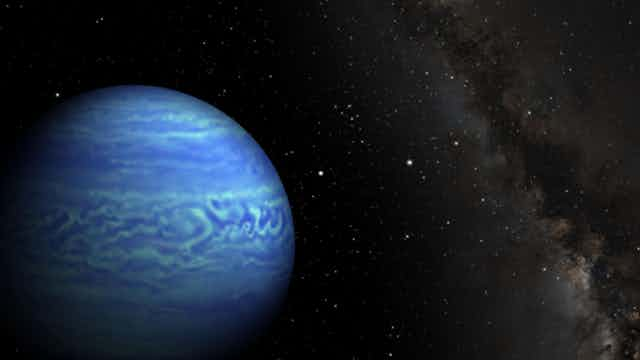Author Douglas Adams famously had his Hitchhiker’s Guide to the Galaxy remark that “space is really big”. But to my mind the sheer vastness of space is better encapsulated in the recent announcement of a new brown dwarf just 7.2 light years away from the sun.
The new inhabitant of the solar neighbourhood is WISE 0855-0714 – a cool brown dwarf somewhere between three and 10 times more massive than the planet Jupiter.
Given that both astronomers and the public are used to regular announcements of the detection of new objects lying tens of billions of light years away at the furthest detectable reaches of the universe, you might wonder why is finding something so nearby so interesting?
A cold discovery
This discovery represents a significant breakthrough because the brown dwarf has an estimated effective temperature of about 250K (on the absolute temperature scale of Kelvin), or -23C. This makes it far and away the coldest, compact object detected outside our solar system yet.
At a temperature of around 250K, WISE 0855-0714 sits about halfway in temperature between the previous record holders (a group of cold brown dwarfs – also discovered by the Wide-field Infrared Survey Explorer WISE – known as “Y dwarfs” with temperatures of around 350K or 77C, about the same temperature as a cup of tea) and the giant planets of our solar system (such as Jupiter) with temperatures of 130K (-143C).
This is critical because although astronomers have discovered more than a thousand exoplanets orbiting other stars over the past 20 years, almost none can be directly observed.
We discover these exoplanets via the impact they have on their host star (either because they transit across their star, or because they make their star wobble), rather than seeing light from them.
WISE 0855-0714’s discovery is exciting because it opens a door to detailed observations that will explore directly the properties of an object with a temperature similar to that of gas giant planets.
New neighbours next door
WISE 0855-0714 lies just 2.2 parsecs (7.2 light years) from our sun, which makes it the fourth closest system now known to us. The even closer systems are the Alpha Centauri AB and Proxima Centauri system at 1.3 parsecs, Barnard’s star at 1.8 parsecs and the WISE 1049-5319 system at 2 parsecs.

Of these four systems, two (Alpha/Proxima Centauri and Barnard’s star) have been known for more than a hundred years, while the other two (WISE 0855-0714 and WISE 1049-5319) have been discovered in just the past few years.
Why is this? How can we be still be uncovering new solar neighbours in an age when discoveries at the edge of the observable universe are the stuff of every day news? Surely objects at seven light years should be a doddle to find, compared to things at tens of billions of light years?
But you’d be wrong.
And the reason is that objects such as WISE 0855-0714 (and indeed gas giant planets such as Jupiter) are incredibly faint. We are used to thinking of Jupiter as a bright and easily visible object in our night skies.

But that is only so because we see light from our sun reflected from Jupiter. Without that reflected sunlight, Jupiter would be invisible at optical wavelengths and only detectable in the infrared at wavelengths beyond 10um (micrometres).
Even then Jupiter would only be detectable because it is so close. It sits a distance of about 778 million kilometres from the sun. This means Jupiter is 88,000 times closer to us than WISE 0855-0714, or 7.7 billion times brighter.
It’s this combination that has made the detection of WISE 0855-0714 such a challenge – it is very faint and only detectable at infrared wavelengths longer than 4um.
More than a WISE discovery
Its discovery has required the development and launch of a US$208 million satellite – NASA’s Wide-field Infrared Survey Explorer.
It took a detailed examination of a database containing more than 700 million objects from WISE’s survey of the entire celestial sphere to find the one needle in the 700 million blade haystack that is WISE 0855-0714.
This was followed by observations using the world’s largest ground-based telescopes, combined with additional data from NASA’s US$2.2 billion Spitzer infrared space observatory.
And even then, WISE 0855-0714 remains ridiculously hard to observe. On a recent observing run using the 6.5m Magellan telescope in Chile, I spent over an hour obtaining an image of the field where this object lies.
But even then, we couldn’t see WISE 0855-071 at a depth of 24th magnitude in the near-infrared. It is so very cool that Magellan – and every other ground-based telescope in the world – has so far failed to be able to detect it.
Which brings me back to why space is so very big – its not just because the distances are ridiculously large (and they are). But also because sometimes the most interesting things to look for are very, very faint.
It’s a combination that means the things we most want to find in the universe are still sitting out there in the depths of space, waiting to be discovered.

